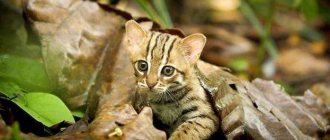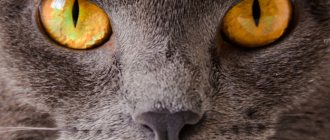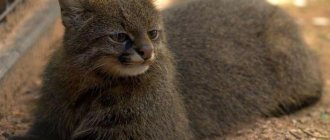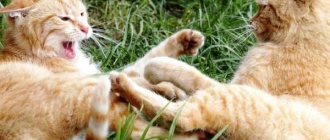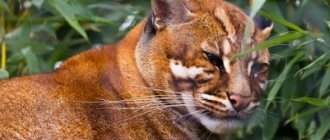Description, lifestyle and habitat in the wild
In appearance, the Andean cat is almost identical to the Pampas cat, which lives next to the species in question. Scientists have still not established their main differences, and research on this matter has been ongoing for many years.
Did you know? Andean cats were first described in 1865, but evidence of their existence before 1998 was only two photographs taken by researchers during an expedition in the 1980s. New observations, which made it possible to better understand Andean predators, were made by researchers at the end of 1998.
The predator lives in northern Chile, southern Bolivia, and northwestern Argentina. The entire habitat is more than 600 square meters. km. The animal's favorite habitat is a rocky valley surrounded by ridges and slopes. The cat has adapted well to the conditions of a dry, cold climate. In order to catch food, the predator is able to travel long distances and conquer impressive heights, up to 5 km.
Despite the fact that the predator looks very much like lazy domestic carefree cats, it is not at all similar to them in its lifestyle and behavior in nature. He is dexterous and maneuverable, has more developed hearing, which allows him to hear the slightest rustle at a great distance and hide from danger. Animals tend to be solitary and do not tend to live in packs.
Sometimes they betray their principles; this period falls during the mating period, which can be replaced by caring for the offspring, but when they grow up and are able to hunt on their own, the animals again go into solitary existence. One individual occupies a property of 40 square meters. km, which is marked with excrement and protected from other predators.
Important! Predators make their lair in the most remote and hard-to-reach places, which include rocky areas, rock crevices, and thickets of low-growing bushes. Thanks to these conditions, animals are protected from other predators.
What is the Andean Forest Cat?
The first description of the Andean cat dates back to 1865, and the first photographs of the animal were taken only in the 1980s. It was they who proved the existence of these predators. The fact is that cats live in hard-to-reach places where no researcher has ever set foot. In 1998, another expedition of scientists to the Andes took place and during the trip they managed to learn more about the cat, for example, they found out that it is quite hardy.
The first video recordings of the beast appeared only in 2000, but scientists considered this a great achievement.
The first video footage of the Andean cat appeared in 2000
Researchers can only guess about the size of the animal’s population. They suggest that it is small - approximately 2.5 thousand individuals. Therefore, the cat was listed in the Washington Convention (CITES), an international government agreement signed for the purpose of nature conservation, which Russia joined in 1992. According to him, any products made from Andean cats are prohibited. The cat is listed in the Red Book as a rare endangered species. In 1999, biologists from around the world created the Andean Cat Alliance, which included researchers from:
- Chile;
- Bolivia;
- Peru;
- Argentina;
- USA.
Scientists quickly developed a plan to preserve these animals. It included solving the following problems:
- how to deal with threats that prevent the animal from spreading;
- how to attract local residents to protect the cat.
Preservation of the Andean cat in natural conditions is complicated by the destruction of the main source of food - mountain chinchillas, which are shot by hunters for their expensive fur. And residents of Bolivia and Peru kill cats because of superstition - in their opinion, violence against animals is a good sign.
The closest relative of this cat is the ocelot from the genus of tiger cats. According to some taxonomists, the Andean beauty is also included in this genus.
The ocelot is the closest relative of the Andean cat
Table: place in the classification of the Andean cat
| Domain | Eukaryotes |
| Kingdom | Animals |
| Type | Chordata |
| Class | Mammals |
| Squad | Predatory |
| Family | Felines |
| Genus | South American cats |
| View | Andean cat |
Appearance
- Length. The Andean cat reaches about 70 cm in length, while its tail is very long and is more than 40 cm.
- Weight. The animal weighs at least 4 kg, some individuals are especially large and reach 7 kg in weight.
- Wool. The animal has long and fluffy hair, which helps protect the body from severe frosts and piercing icy winds.
- Color. The animal is painted brown-gray with black inclusions in the form of spots. The tail is colored gray-black, which is presented in the form of fairly large stripes of equal width.
- The height at the withers reaches 37 cm.
- Character. The animal is distinguished by its warlike and fearless character, it is active and fast. In his free time from hunting, the predatory animal likes to relax in grassy thickets. Usually hunts at night.
Who does it hunt and what does it eat?
A predator, in order to survive, must constantly be in shape. The predator shows all its best qualities during the hunt, which is necessary not only to feed itself and its offspring, but also to train agility and speed that allow it to elude other, large predators.
The animal can hunt at any time, but still prefers twilight. To catch food, the animal can hide and wait for the right moment in ambush or track prey by sound and smell. To catch a small bird, a predator does not need many attempts; it pounces on its prey suddenly and almost always gets what it wants. The diet of the Andean cat includes small birds and their chicks and bird eggs. It doesn’t mind eating insects, reptiles, small mammals, and some plants. The most common prey is chinchilla and mountain whiskey.
Did you know? Animals hunt at dusk because they can see in the dark, thanks to the ability of their eyes to reflect light, and their victims do not have this ability and are more defenseless at this time of day.
Reproduction and care of offspring
There is no officially confirmed information about the breeding process of Andean cats, since observing these animals in the wild is very difficult. Most researchers, based on the information received, are inclined to believe that their breeding season falls on April-July. At this time, the female may have from one to three babies. The animals reach sexual maturity at the age of two.
As for caring for the offspring, female Andean cats do this; they feed their babies with milk until a certain age, then teach them to hunt. At this time, the kittens become independent and do not need care, so the adult leaves them and goes to its own territory.
Wild felines - oncilla, jungle cat, black-footed cat, jaguarundi, manul, caracal - are so similar to cute domestic cats, but have a predatory disposition.
Description of the Andean cat
Its appearance makes the Andean cat distinguishable from other wild felines, but in some ways it resembles the Pampas cat. In size, the Andean forest is slightly larger than its domestic relative.
According to scientists, the Andean cat is similar to the Pampas cat
External features
The Andean cat is approximately 70 cm long and weighs 4–7 kg. In its structure, the animal is similar to its domestic relative.
The cat's fur is quite long and protects from the cold. The fur color is gray-brown, with a silver tint and dark spots. Their pattern is similar to that which can be seen in the snow leopard. The tail is long (45 cm) and quite fluffy, serving as a blanket for the animal during cold weather. It has a ring-shaped pattern on it.
The Andean cat differs from all representatives of small wild cats in that its fur has stripes.
Character
During rare meetings with people, the Andean cat does not make any special attempts to escape from humans. Therefore, researchers manage to get quite close to it.
In 1998, one researcher followed an Andean cat that came very close to his camp. He filmed it for 5 hours, and the animal behaved as if nothing had happened - yawned, stretched, “wetted” the stones and even managed to sleep a little. And after that he continued hunting.
The Andean cat is practically not afraid of humans, which indicates its fearlessness
These observations indicate that the cat is fearless and quite loyal to humans. It occupies the territory as long as there are viscachas on it - rats that these cats feed on. To successfully live and raise offspring, they need a territory with two or at least one colony of rodents for food.
The only radio-collared Andean cat occupied an area of 47 m2. Scientists suggest that cats roam over larger areas, but there is no scientific evidence to support such arguments. It is also believed that two or three females usually live in the territory of one male.
Habitat
Habitats of the Andean cat - highlands:
- Peru;
- Bolivia;
- Chile;
- Argentina.
These animals climb to mountain heights of 3.5–5 thousand meters, going far beyond the forest. That is why they have been little studied.
The highlands of South America are the habitat of the Andean cat
A completely normal temperature range for cats is considered to be 0–4 °C - this is exactly how many degrees remain in the highlands. But higher digital values (4–16 °C) are also acceptable for the Andean cat. The animal also takes frosts calmly. In addition, it can live for a long time without water.
Sometimes the cat can be found in Argentina at lower altitudes - this is where scientists encountered it. It is possible that she came down from the mountains to find food and water. The animal was also spotted in the Peruvian pampas.
Nutrition
The Andean cat feeds on small rodents and reptiles:
- lizards;
- viscachas (mountain rats);
Andean cats eat viscacha, a member of the chinchilla family.
- mountain chinchillas;
- phyllotid mice;
- tinamu (birds resembling partridges).
The Andean cat is helped to catch up with prey by its long tail, which is used as a balancer.
Reproduction
There is little information about the reproduction of the Andean cat. Kittens are usually shown in the mountains in April–October. Therefore, it can be assumed that the animal breeds from November to December or from July to August. A female has 1–2 cubs in a litter. They become sexually mature at the age of two.
Andean kittens become sexually mature at two years of age
Males do not participate in raising kittens. The life expectancy of the animal is 9 years.
Number and conservation status
Due to the fact that the population of the mountain animal decreases every year, it is listed in the Red Book as an endangered species.
The exact number of Andean cats has not yet been established; the approximate figure is no more than 2000 individuals. Additionally, the Andean cat is listed as endangered in the United States according to Appendix I of the Convention on International Trade in Endangered Species of Wild Fauna and Flora. In countries where their main habitat is located, animals are protected by law; trade and hunting of Andean cats is prohibited.
Bengal cat, Serengeti, Toyger, Chausie, Savannah are domestic cat breeds with genes of wild predators.
Number of species leopardus jacobita
Naturalist researchers suggest that the number of Andean cats does not exceed 2,500 individuals. The natural enemies of these animals are unknown, but there is evidence that humans played a negative role in reducing the number of the species. One version of why this happened is that the Andean people began to die out due to insufficient food. People exterminate rodents that wild predators feed on. In particular, chinchilla fur has long been highly valued on the world market.
The Andean cat is one of the rarest species that inhabit South America. The species is listed in the International Red Book. Appendix I of the CITES Convention contains a list of all rare animals, and the Andean cat is listed on the most restrictive list of the appendix. According to the document, trade in this species is strictly prohibited.
In 2004, the Alliance for the Study and Conservation of the Andean Cat was created. The alliance includes conservationists from Argentina, Bolivia and other countries where cat tracks were found. Perhaps a solution will soon be found to how to preserve and increase the numbers of this most mysterious of species.
The Andean cat is a wild carnivore from the cat family. This is a small animal that has the most inconspicuous appearance. The Andean cat can blend in with nature thanks to its talent for camouflage. Such animals can be called survival specialists, because they have to hide, feed and reproduce in the harshest climatic conditions. No matter how hard people tried, they were unable to tame such an animal. This animal cannot survive in the conditions offered by man. In addition, buying and selling a cat of a rare species is considered a crime.
Is it possible to keep in captivity?
There is not a single case of successfully keeping an Andean cat in captivity. Even if they live in zoos, where it is possible to create the most comfortable conditions similar to wild nature, these animals do not survive and die within a year.
It is also impossible to breed Andean cats in specialized nurseries, which could greatly increase the population of these animals and correct the situation that threatens complete extinction.
Keeping the Andean cat in captivity
For the freedom-loving Andean cat, living in captivity is not possible. All attempts to keep her in zoos ended sadly - not a single animal, even with the best care, could survive there for more than a year. For a predator accustomed to vast open spaces and fresh winds, the musty air of enclosed spaces is destructive.
Captive breeding programs for endangered species, which have long been effective in increasing the numbers of many other rare animals, are unfortunately unacceptable for the Andean cat.
Captivity is a quick death for the Andean cat
This species is not kept in any zoo in the world . There is no information that Andean cats are present in any of the private collections of exotic animals, despite the strange fashion for home zoos and rare predators. It is impossible to legally purchase Andean kittens or adults - trading in representatives of this species is illegal and entails criminal liability for the seller.
If some specimens are smuggled into private ownership, they are absolutely not amenable to domestication, and soon become ill and die. Born free, this little hut can and should live only in the wild, in its natural habitat - on the high mountain slopes of the harsh Andes.
